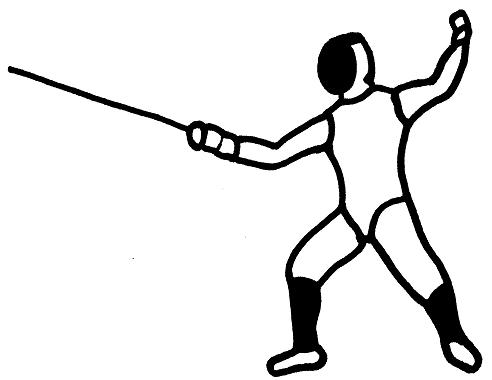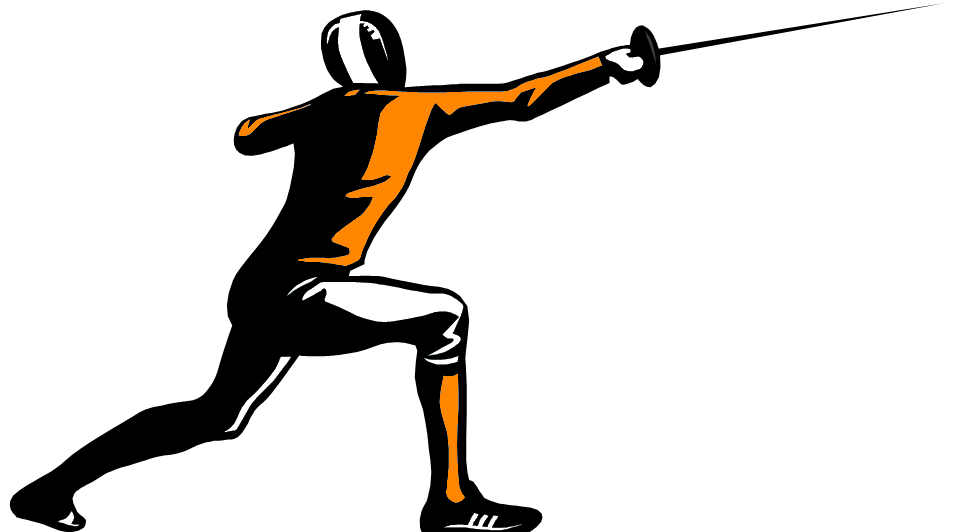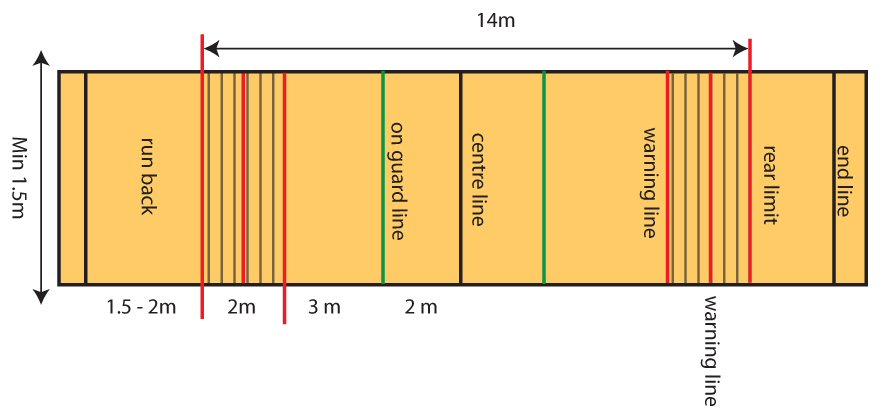![]()
Gearing Up
Wearing proper attire while fencing is a must. Remember, we are playing with swords after all! A modern fencing setup includes a good pair of shoes, knee high socks, knickers, plastron, jacket, mask, glove and of course a weapon (and this is just for fencing dry)! The purpose to all this gear is to pad the body completely while also ensuring there are no places for a blade to snag. Additionally, men need to wear a protective cup and women need wear breast protectors. I think you know their purpose, and trust me, you don't want to be caught without them.
En Garde!
Our club fences in a very traditional manner. In this way, the fencers feet are placed shoulder width apart with the rear foot turned no more than 90 degrees to the side. The rear foot is also moved forward slightly to be off of the line of attack (shown in red) which helps the fencer avoid tripping over their own feet. This is illustrated below.


The fencer then bends their knees until the tips of their toes are no longer visible. It should be a fairly loose, relaxed stance. The shoulders should be directly above the hips and the fencer should not be leaning or hunching over. Leaning or hunching will throw off your balance and make it much more difficult to move quickly. The arms are then raised as shown above, loose and relaxed and ready to fight.
The Footwork
The best way to learn footwork is to get out and do it, though I'll describe some aspects here. Footwork consist of a number of SMALL and QUICK movements with the feet. Small/quick movements allow a fencer to change direction almost instantaneously. This helps not only on defense but on offense as well. The reason is that being able to manipulate the distance between you and your opponent is absolutely critical to fencing. Idealy you want to be just out of your opponents attacking distance, sneaking in and out of range until you are in range to launch your own attack. Some of the basic footwork you will start with are the advance, retreat, and lunge (below).

Target Area and Weapons
Fencing has evolved into three different styles, foil, epee and saber. In foil fencing, only by depressing the tip of the weapon can a fencer score a touch. Additionally, it must land on the torso of the opponent (arms, legs and head are not valid target area). Epee is similar in that a touch can only be obtained by depressing the weapons point, though the entire body is target area, from head to toe. The third style of fencing is saber. A saber is a slashing weapon and as such the entire length of the blade (front and back) can be used to score touches. As this sport developed from the cavalry days, valid target area is from the waist up (you don't want to hurt the horse after all!). These target areas are shown below.

Bouting, Scoring and Directing
Fencing takes place on a 'piste' or 'strip'. It is at least 14 meters long and 1.5 meters wide. A round of fencing is called a 'bout' and occurs between 2 fencers. A fencing bout lasts 3 minutes or until a fencer scores 5 touches, whichever comes first. In a tournament, direct elimination bouts consist of 3 rounds of 3 minutes (with a 1 minute break between) or the first to score 15 touches. Bouts are watched by a director and possibly judges if electric scoring equipment is not available. A director is essentially a referee. He tells the fencers when to start and stop, and determines when touches are scored. It's not just as simple as watching who poked who, but calling the action according to the rules of 'right of way'. You must have the right to attack and must establish the attack according to the rules. A proper defensive move can take away that right to attack and allow a defender to make a riposte. It's a little bit tricky and varies between the different fencing styles, though is critical to understanding fencing. More information can be found at the USFA Web site or can be discussed during club meetings.

Terminology
Advance - Basic forward footwork movement.
Attack - An offensive action made by extending the arm and threatening target area.
Bout - A fencing match, typically between two competitors
Director - Directs a fencing bout and awards touches.
Dry Fencing - Fencing without electric scoring equipment.
Electric Fencing - Fencing with electric scoring equipment.
En Garde - Meaning 'on guard'. The stance used for fencing.
Epee - A style of fencing in which the entire body is target area. Also, a style of weapon.
Foil - A style of fencing in which only the torso is valid target area. Also, a style of weapon.
Lame - An electrically conductive jacket worn during an electric bout to indicate a touch.
Lunge - One of the most basic and common attacks in modern fencing.
Parry - A defensive move in which the opponent's attack is blocked.
Piste - The area in which fencing bouts take place.
Plastron - A protective piece of clothing worn primarily around the shoulder of the weapon arm.
Recovery - Returning to the en garde position, typically after a lunge.
Retreat - Basic backwards footwork movement.
Riposte - The immediate attack that typically follows a parry.
Saber - A style of fencing in which the waist up is valid target area. Also, a style of weapon.
Salle - A place of fencing (i.e. a gym).
Salute - A blade action typically performed before and after a bout or drill. Symbol of respect.
Strip - The area in which fencing bouts take place.
Target Area - The part of the body that a fencer may score a point on.